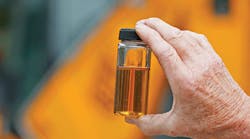Modern hydraulic systems require filtration with a Beta ratio of 200 (99.5% of contaminant particles removed) or 1000 (99.9% of contaminant particles removed) to realize maximum service life. But, the Beta ratio is only the beginning of the cleanliness story.
A filter’s dirt-holding capacity, pressure-drop characteristics, and Beta-ratio stability are also critically important. Beta-ratio stability is the ability of a filter element to perform well in today’s dynamic hydraulic systems, not just in a laboratory. In practical terms, this means a cartridge-type filter is nearly always the best choice.
Today’s best filter cartridges use multiple layers of synthetic media to maximize performance in all areas. Each filter layer provides a certain function that can support filtration performance, dirt-holding capacity, or beta stability.
Cartridge-type filters also help drastically reduce the fluid loss that occurs each time a spin-on type of filter is changed, resulting in a positive impact on economics as well as the environmental. Considered together with the extended component life that can be expected from a properly protected system, these factors easily offset the slightly higher cost of the cartridge-type filter.
Cartridge filters are the standard in industrial hydraulic applications. They’re also seeing wider adoption in the mobile environment, which also faces rising operating pressures and greater component sophistication.
Mobile Challenges and Solutions
Space is always a major consideration in mobile equipment, and the extra components involved in Tier 4-compliant diesel after-treatment systems make this issue more critical than ever. One successful approach for minimizing the filtration footprint is to use tank-top filters integrated into the hydraulic reservoir. Filter OEMs have developed a number of successful designs for this application, and some reservoir manufacturers now offer pre-installed versions as standard equipment. This trend is sure to accelerate in light of tightening global emission requirements.
Cold-start issues also are unique to the mobile environment. Hydraulic fluids thicken at low temperatures, which will increase the pressure drop across the filter element. Performance degrades until the fluid reaches operating temperature. This phenomenon is most often equated with the operator’s comment that says “I started up and hit the lever, but nothing happened.”
Installing a larger filter is one solution, but it adds cost and bulk to the system. Another common workaround involves simply bypassing the filter via a pressure relief valve until the fluid comes up to temperature. The downside of that approach, though, is it sends contamination directly downstream. A more practical approach uses a bypass valve, but returns the unfiltered fluid to the reservoir instead of letting it circulate through the system.
Achieving Realistic Goals
With today’s filtration technology, an attainable goal for mobile equipment is to reduce fluid contamination to the point whereby it no longer contributes to the failure of any system component during the component’s reasonably expected lifetime. To get there, a target cleanliness level must first be set, one that considers a system’s specific operational needs.
Cleanliness is a very specific quantitative value arrived at using a laboratory particle counting procedure defined by the ISO 4406:99 standard. While it’s too complex to include here, the important output is a cleanliness code consisting of three numbers, e.g. 17/14/12, that represent the number of particles of a specific size found in the oil sample.
The aforementioned contamination/component failure charts are based on cleanliness levels applied to the most contamination-sensitive system components. Fluid-power professionals should use these guidelines to help define target cleanliness levels for particular hydraulic systems.
After defining those levels, the only way to measure success is to monitor fluid conditions systematically. Traditionally, samples are sent to a lab for analysis, but that isn’t always easy to accomplish with mobile equipment. Fortunately, Eaton and some other filtration suppliers now offer portable “Lab-In-A-Suitcase” solutions that can be used to monitor fluid cleanliness in the field (see “Fluid Lab in a Suitcase”).
Contamination sources for mobile equipment is a topic worthy of a whole series of articles, but the key point is: Never assume that the fluid going into your system is clean unless you are filtering it as it’s being put into the reservoir. A cartridge filter is one of the most cost-effective tools available for hydraulic system maintenance, and will pay for itself many times over by extending the life of expensive components.
Building a Strategy
A well-planned and consistently applied filtration strategy built around modern cartridge filtration systems and systematic fluid monitoring will extend the life of critical hydraulic components and improve the productivity and uptime availability of mobile equipment. It will also extend the life of hydraulic fluids and reduce the cost of proper disposal of used fluids and filter elements.




